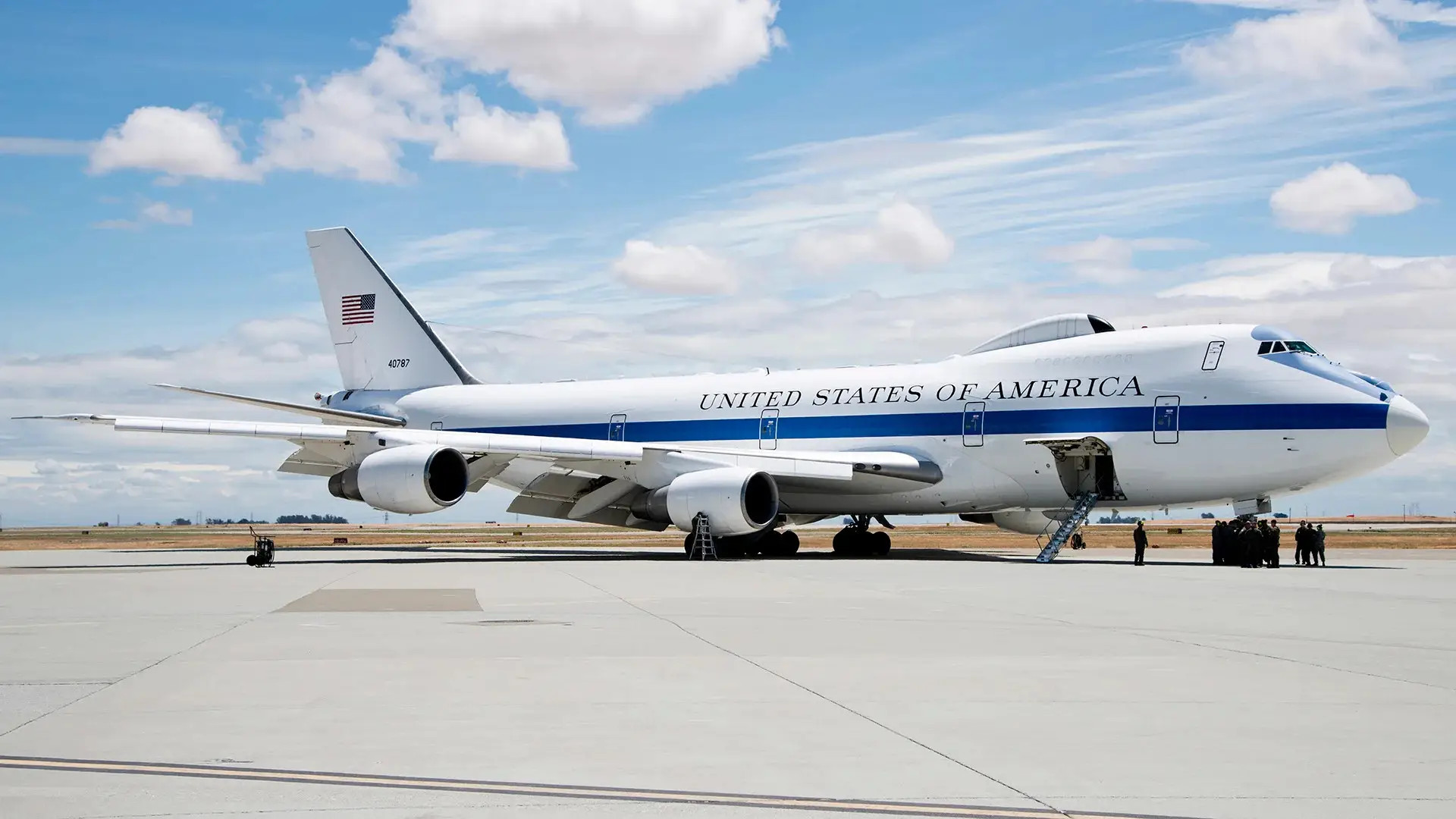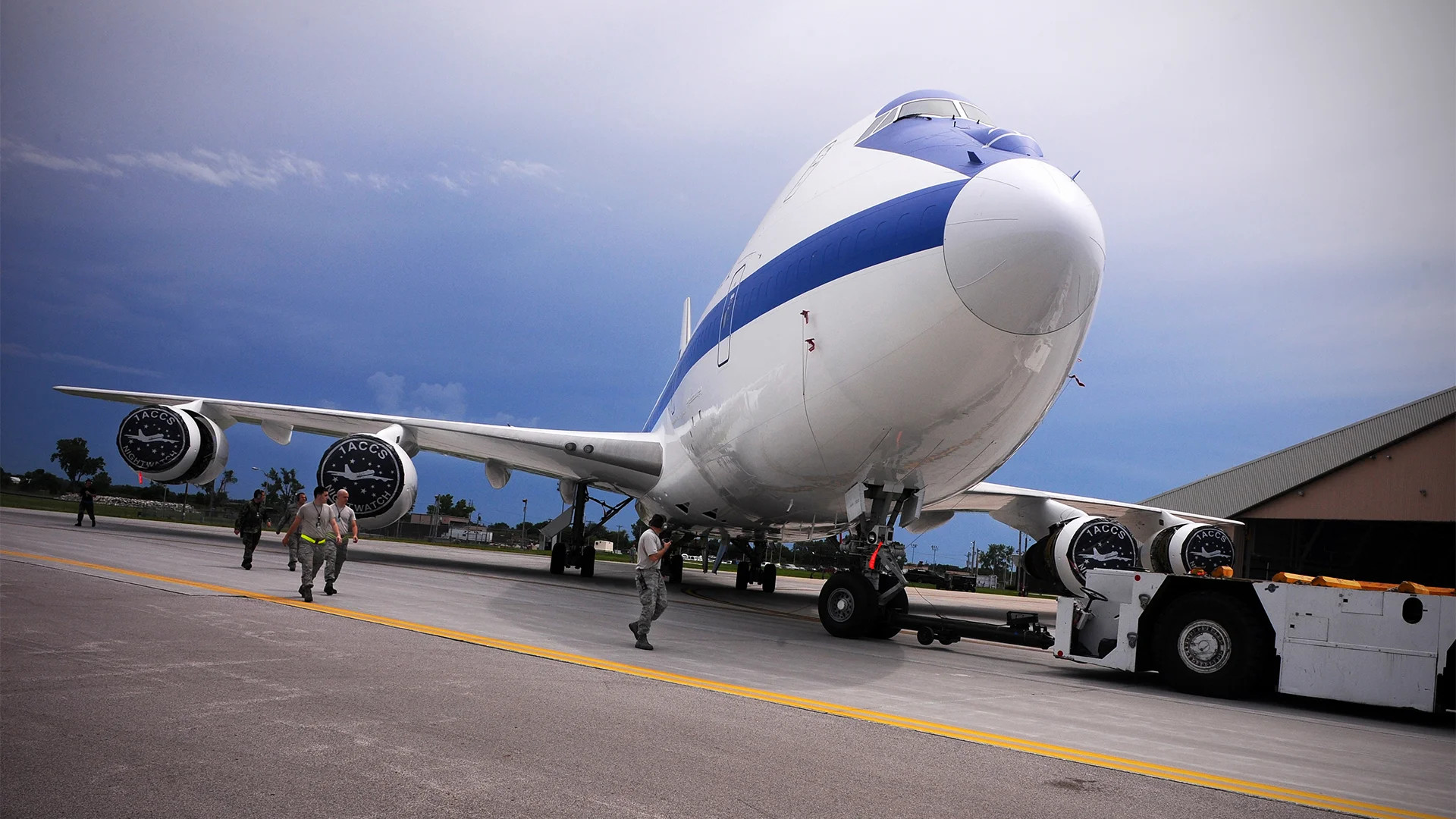The U.S. Air Force has awarded the Sierra Nevada Corporation (SNC) a contract valued at more than $13 billion to deliver a fleet of highly specialized Survivable Airborne Operations Center (SAOC) aircraft. These planes will help ensure the President and other senior military officials can perform their duties, including directing nuclear strikes, no matter what, and are set to succeed the service’s aging Boeing 747-200-based E-4B Nightwatch ‘doomsday planes.’ SNC had been widely expected to win this deal after incumbent Boeing dropped out last year.
SNC’s contract award for what is formally known as the Survivable Airborne Operations Center (SAOC) program, which includes incentives, is valued at $13,080,890,647, according to a daily notice from the Pentagon. It’s unclear how many total SAOCs the Air Force plans to buy. The service only has four E-4Bs in service now, but there has been talk of its acquiring between eight and 10 SAOCs in the past. The War Zone has reached out to the Air Force and SNC for more information.

“This contract provides for the development and production of the SAOC Weapon System to include the delivery of engineering and manufacturing development aircraft, associated ground systems, production aircraft, and interim contractor support. Work will be performed in Englewood, Colorado; Sparks, Nevada; Beavercreek, Ohio; and Vandalia, Ohio, and is expected to be completed by July 10, 2036,” today’s daily contracting notice from the Pentagon says. “This contract was a competitive acquisition, and two offers were received. Fiscal 2024 research, development, test, and evaluation funds in the amount of $59,000,000 are being obligated at [the] time of award.”
Though not yet confirmed, the assumption is that SNC’s SAOCs will be conversions of second-hand late-model 747-8is. Further supporting this belief was SNC’s ribbon-cutting ceremony for a new 90,000-square-foot maintenance, repair, and overhaul hangar specifically sized to accommodate the 747-8 in Dayton, Ohio last August.

The Air Force had previously stipulated that the SAOC aircraft had to have four engines and, as The War Zone previously explored, this together with operational security and other requirements seemed to preclude proposals based on any aircraft besides the 747. Boeing is currently in the process of converting a pair of 747-8is originally built for a defunct Russian airline (which never took delivery of them) into new VC-25B Air Force One jets for many of the same reasons. There is also no option to use new-production 747 airframes with the shuttering of that production line in 2022. What, if anything, may get ported over from the VC-25B configuration to the SAOC, is unknown.

Specific details about SNC’s SAOC configuration are scant, but they will need to have advanced and highly secure communications suites and hardening against electromagnetic pulses, among other capabilities. The aircraft will be filling the role in which the Air Force’s four E-4Bs, also known as National Airborne Operations Centers (NAOC) jets, currently serve. Three of the E-4Bs started life as E-4A Advanced Airborne Command Posts (AACP), entering service in the 1970s. They were subsequently brought up to the NAOC standard in the 1980s. A fourth aircraft in the NAOC configuration was then also acquired.
The core mission today of the E-4B is to provide a robust and survivable airborne command post that the President of the United States, via a mechanism known as the National Command Authority (NCA), can use to initiate a nuclear strike from anywhere in the world. This is why these aircraft are commonly called ‘doomsday planes.’ The secure communications and other capabilities found on the Nightwatch jets mean they can also be used, as required, as aerial platforms to direct other kinds of military operations or contingency response activities, including in response to severe natural disasters.
As such, an E-4B typically shadows the President on trips overseas in case the Commander in Chief needs to make use of their capabilities. The Secretary of Defense and other senior U.S. officials often use the Nightwatch aircraft for visits to foreign countries, as well. You can read more about these aircraft and their place within the U.S. government’s broader continuity of government plans, which are in place to ensure critical national-level authorities can continue functioning even in the face of the most severe crises, here.

Regardless of whatever the configuration of the SAOC aircraft might be in the end, SNC getting this contract is a major coup for the company that is best known for its aircraft modification work. It’s similarly another blow to Boeing, which has suffered from myriad setbacks across its defense and commercial portfolios in recent years.
“We are approaching all new contract opportunities with added discipline to ensure we can meet our commitments and support the long-term health of our business. We remain confident our SAOC approach is the most comprehensive, technically mature, and lowest-risk solution for the customer and Boeing,” a Boeing spokesperson told The War Zone last December in response to questions about its decision to bow out of the SAOC competition. “Our proposal is based on 60 years of military commercial derivative aircraft knowledge and experience including the design, development, and sustainment of the E-4B Nightwatch, which currently serves the national security command and control mission.”
The SAOC program is also just one part of a broader effort within the U.S. military to modernize nuclear command and control capabilities. The U.S. Navy is also working to acquire new C-130J Hercules-based ‘doomsday planes’ with the ability to communicate with submerged nuclear ballistic missile submarines in support of a mission set the service calls Take Charge and Move Out (TACAMO).

A fleet of 16 Boeing 707-based E-6B Mercury aircraft currently performs the TACAMO mission, as well as another Air Force strategic airborne command post mission nicknamed Looking Glass. It is possible that the fleet of SAOCs could eventually take over the Looking Glass mission, at least in part.
Whatever the case, with today’s contract award to SNC, the Air Force is moving ahead with plans that are set to significantly change the look of its ‘doomsday plane’ fleets by the mid-2030s.
UPDATE:
We have received a statement on the contract award from a USAF spokesperson:
“The Department of the Air Force awarded a contract for the Survivable Airborne Operations Center to Sierra Nevada Corp. that will replace the legacy E-4B National Airborne Operations Center.
The SAOC weapon system is intended to replace the aging 1970s-era aircraft, which are approaching end-of-service life.
The development of this critical national security weapon system ensures the Department’s Nuclear Command, Control, and Communications capability is operationally relevant and secure for decades to come.
To satisfy operational requirements, the weapon system will be comprised of a Commercial Derivative Aircraft that will be hardened and modified to meet military requirements.
Additionally, the mission system will integrate secure communications and planning capabilities on modern information technology, infrastructure, based on a Modular Open System Approach.
Another component, the ground support systems, will include aircrew trainers, mission crew trainers, maintenance training devices, ground support equipment, test and sustainment system integration laboratories, and other group systems to enable the operations, sustainment, and future modifications of the SAOC weapon system across its lifecycle.
A secure, reliable, and trusted NC3 capability is fundamental to the nation. Resilient NC3 is critical in deterring adversaries from conducting strategic attacks against our nation and assuring our allies and partners.”
Contact the author: joe@twz.com
